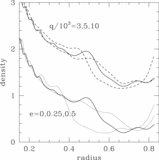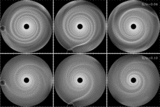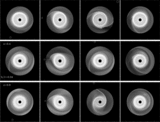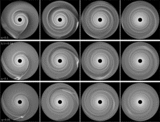Image Details
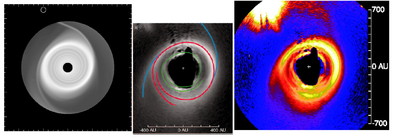
Caption: Fig. 7.
Comparison between a simulation with ﹩q=0.2﹩, ﹩h/ r=0.04﹩, and ﹩e=0.2﹩ (simulation R), with the binary companion HD 141569B, HD 141569C near periapse on a prograde orbit, and the observed morphology of HD 141569A. The images in the middle and on the right are from Clampin et al. (2003). Our simulation does a reasonable job of accounting for the outer spiral structure and the location of the disk edge, matches reasonably well the position of the binary (denoted with a white circle), and predicts an asymmetry in the location of the outermost two arms that is seen in the disk of HD 141569A. Much of the structure of the outer disk may have been excited by the tidal force of the binary HD 141569B, HD 141569C. However, our simulation fails to exactly match the shape of the outermost spiral features and the lopsided nature of the disk. We suspect that a better three‐dimensional simulation would be required to do this. The images of HD 141569A are shown with north to the left and west on top as by Clampin et al. (2003) and Augereau & Papaloizou (2004).
Copyright and Terms & Conditions
© 2005. The American Astronomical Society. All rights reserved. Printed in U.S.A.




